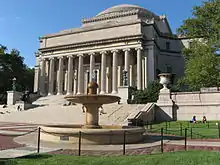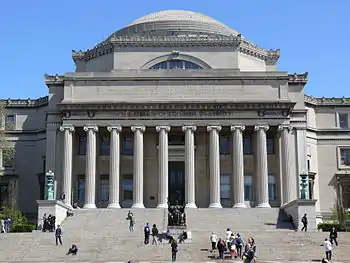Barnard College
Barnard College is a private women's liberal arts college in New York City. It was founded in 1889 by Annie Nathan Meyer as a response to Columbia University's refusal to admit women, and is named after Columbia's 10th president, Frederick Barnard.
 | |
| Latin: Barnardi Collegium | |
Other name | Barnard |
|---|---|
| Motto | Hepomene toi logismoi (Greek) |
Motto in English | Following the Way of Reason |
| Type | Private women's liberal arts college |
| Established | 1889 |
Academic affiliations | Columbia University NAICU Seven Sisters Annapolis Group Oberlin Group Space-grant |
| Endowment | $363.6 million (2019)[1] |
| President | Sian Beilock |
Academic staff | 354 (2019)[2] |
| Undergraduates | 2,631 (2019)[3] |
| Location | , , United States 40.8096°N 73.9635°W |
| Campus | Urban |
| Colors | Blue and white |
| Athletics | NCAA Division I – Ivy League (consortium with Columbia University) |
| Sports | 16 varsity teams |
| Mascot | Millie the Bear[4] |
| Website | barnard |
 | |
The college is affiliated with but legally and financially separate from Columbia. Students share classes, clubs, fraternities and sororities, sports[5] teams, buildings, and more with Columbia, and receive a diploma that is signed by both Barnard and Columbia presidents.
Barnard offers Bachelor of Arts degree programs in about 50 areas of study. Students may also pursue elements of their education at Columbia, the Juilliard School, the Manhattan School of Music, and The Jewish Theological Seminary, which are also based in New York City. Its 4-acre (1.6 ha) campus is located in the Upper Manhattan neighborhood of Morningside Heights, stretching along Broadway between 116th and 120th Streets. It is directly across from Columbia's main campus and near several other academic institutions.
The college is a member of the Seven Sisters, an association of seven prominent women's liberal arts colleges.
History
Founding
.jpg.webp)
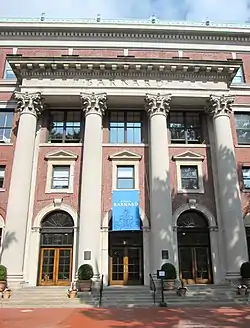
For its first 229 years Columbia College of Columbia University admitted only men for undergraduate study.[6] Barnard College was founded in 1889 as a response to Columbia's refusal to admit women into its institution.
The college was named after Frederick Augustus Porter Barnard, a deaf American educator and mathematician who served as the 10th president of Columbia from 1864 to 1889. He advocated for equal educational privileges for men and women, preferably in a coeducational setting, and began proposing in 1879 that Columbia admit women.[7]
Columbia's Board of Trustees repeatedly rejected Barnard's suggestion,[7] but in 1883 agreed to create a detailed syllabus of study for women. While they could not attend Columbia classes, those who passed examinations based on the syllabus would receive a degree. The first such woman graduate received her bachelor's degree in 1887. A former student of the program, Annie Meyer,[8] and other prominent New York women persuaded the board in 1889 to create a women's college connected to Columbia.[7][9]
Men and women were evenly represented among the founding Trustees of Barnard College. The males were Rev. Dr. Arthur Brooks (chair of the board), Silas B. Brownell, Frederick R. Coudert, Noah Davis, George Hoadley, Hamilton W. Mabie, George Arthur Plimpton, Jacob Schiff, Francis Lynde Stetson, Henry Van Dyke, and Everett P. Wheeler.[10]:212 The founding female trustees of Barnard College were Augusta Arnold (née Foote), Helen Dawes Brown, Virginia Brownwell (née Swinburne), Caroline Sterling Choate, Annie Nathan Meyer, Laura Rockefeller, Clara C. Stranahan (née Harrison), Henrietta E. Talcott (née Francis), Ella Weed, Alice Williams, and Frances Fisher Wood.[11][10]:212
Barnard College's original 1889 home was a rented brownstone at 343 Madison Avenue, where a faculty of six offered instruction to 14 students in the School of Arts, as well as to 22 "specials", who lacked the entrance requirements in Greek and so enrolled in science.[12]
Morningside campus
When Columbia University announced in 1892 its impending move to Morningside Heights, Barnard built a new campus nearby with gifts from Mary E. Brinckerhoff, Elizabeth Milbank Anderson and Martha Fiske.[13] Two of these gifts were made with several stipulations attached. Brinckerhoff had offered $100,000 in 1892, on the condition that the Barnard acquire land within 1,000 feet of the Columbia campus within the next four years.[14] The Barnard trustees purchased land between 119th-120th Streets after receiving funds for that purpose in 1895.[15][16] Anderson, who gave $170,000, requested that Charles A. Rich be hired.[17] Rich designed the Milbank, Brinckerhoff, and Fiske Halls, built in 1897–1898;[17] these were listed on the National Register of Historic Places in 2003.[18] The first classes at the new campus were held in 1897. Despite Brinckerhoff's, Anderson's, and Fiske's gifts, Barnard remained in debt.[13]
Ella Weed supervised the college in its first four years; Emily James Smith succeeded her as Barnard's first dean.[7] Jessica Finch is credited with coining the phrase "current events" while teaching at Barnard College in the 1890s.[19]
As the college grew it needed additional space, and in 1903 it received the three blocks south of 119th Street from Anderson who had purchased a former portion of the Bloomingdale Asylum site from the New York Hospital.[20][21] Rich provided a master plan for the campus, but only Brooks Hall was built, being constructed between 1906 and 1908.[22][23] None of Rich's other plans were carried out. Students' Hall, now known as Barnard Hall, was built in 1916 to a design by Arnold Brunner.[24] Hewitt Hall was the last structure to be erected, in 1926–1927.[23] All three buildings were listed on the National Register of Historic Places in 2003.[18][25] An inability to raise funds precluded the construction of any other buildings.[25]
By the mid-20th century Barnard had succeeded in its original goal of providing a top tier education to women. Between 1920 and 1974, only the much larger Hunter College and University of California, Berkeley produced more women graduates who later received doctorate degrees.[26] In the 1970s, Barnard faced considerable pressure to merge with Columbia, which was fiercely resisted by its president, Jacquelyn Mattfeld.[27]
Academics
Barnard students are able to pursue a Bachelor of Arts degree in about 50 areas of study.[28] Joint programs for the Bachelor of Science and other degrees exist with Columbia University, Juilliard School, and The Jewish Theological Seminary. The most popular majors at the college include Economics, English, Political Science, History, Psychology, Biological Sciences, Neuroscience, and Computer Science.[29]
The liberal arts general education requirements are collectively called Foundations. Students must take two courses in the sciences (one of which must be accompanied by a laboratory course), study a single foreign language for two semesters, and take two courses in the arts/humanities as well as two in the social sciences. In addition, students must complete at least one three-credit course in each of the following categories, known as the Modes of Thinking: Thinking Locally—New York City, Thinking through Global Inquiry, Thinking about Social Difference, Thinking with Historical Perspective, Thinking Quantitatively and Empirically, and Thinking Technologically and Digitally. The use of AP or IB credit to fulfill these requirements is very limited, but Foundations courses may overlap with major or minor requirements. In addition to the distributional requirements and the Modes of Thinking, students must complete a first-year seminar, a first-year writing course, and one semester of physical education. Foundations replaced the old general education requirements, called the Nine Ways of Knowing, in 2016.[30]
Admissions
| 2020[31] | 2019[32] | 2018[33] | 2017[34] | 2016[35] | |
|---|---|---|---|---|---|
| Applicants | 9,411 | 9,320 | 7,897 | 7,716 | 7,071 |
| Admits | 1,022 | 1,097 | 1,099 | 1,190 | 1,184 |
| Admit rate | 10.8% | 11.8% | 13.9% | 15.4% | 16.7% |
| Enrolled | N/A | 632 | 605 | 603 | 605 |
| SAT mid-50% range* | N/A | 1360-1500 | 1330-1500 | 1310-1500 | 1270-1470 |
| ACT mid-50% range | N/A | 31-34 | 30–33 | 30–33 | 29–33 |
| * SAT out of 1600 |
Admissions to Barnard is considered most selective by U.S. News & World Report.[36] It is the most selective women's college in the nation;[37] in 2017, Barnard had the lowest acceptance rate of the five Seven Sisters that remain single-sex in admissions.[38]
The class of 2023's admission rate was 11.8% of the 9,320 applicants, the lowest acceptance rate in the institution's history.[39] The early-decision admission rate for the class of 2023 was 23.9%, out of 1,221 applications.[32] The median SAT Composite score of enrolled students was 1440, with median subscores of 720 in Math and 715 in Evidence-Based Reading and Writing.[32] The median ACT Composite score was 33.[32]
In 2015 Barnard announced that it would admit transgender women who "consistently live and identify as women, regardless of the gender assigned to them at birth", and would continue to support and enroll those students who transitioned to males after they had already been admitted.[40]
Rankings
| University rankings | |
|---|---|
| National | |
| Forbes[41] | 50 |
| THE/WSJ[42] | 59 |
| Liberal arts colleges | |
| U.S. News & World Report[43] | 22 |
| Washington Monthly[44] | 24 |
Barnard was ranked tied at 22nd overall, tied for 29th out of 50 "Most Innovative Schools", tied for 57th out of 63 schools for "Best Undergraduate Teaching" and 81st out of 102 schools for "Best Value" for 2021 among U.S. liberal arts colleges by U.S. News & World Report.[45] Forbes ranked Barnard the 19th best liberal arts college in 2019, which also ranked it 50th among 650 universities, liberal arts colleges and service academies.[46]
Campus
Library
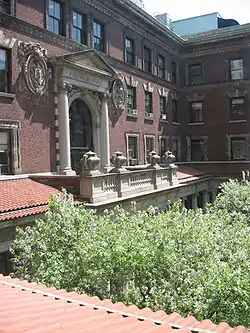
While students are allowed to use the libraries at Columbia University, Barnard has always maintained a library of its own. Lehman Hall was the site of Barnard's Wollman Library from its opening in 1959 until 2015.[47] In August 2016, Lehman Hall was demolished to make way for a new library facility.[48] Barnard's Milstein Center for Teaching and Learning opened in September 2018.[49] In 2016, portions of the Barnard Library were relocated to the former LeFrak Gymnasium, the first two floors of Barnard Hall.[50] 18,000 volumes were also moved to the Milstein rooms in Columbia University's Butler Library.[51] The relocation plans proved to be contentious among faculty at the college, who objected to sending a large portion of the library's holdings off site, as well as a "lack of transparency surrounding the decision-making process", according to Library Journal.[47]
The LeFrak Center housed study space, librarians' offices, the zine collection, course reserves, and new books acquired after July 2015-.[52] The Barnard Library also encompasses the Archives and Special Collections, a repository of official and student publications, photographs, letters, alumnae scrapbooks and other material that documents Barnard's history from its founding in 1889 to the present day.[53] Among the collections are the Ntozake Shange papers[54] and various student publications.[55]
Barnard Public Safety Shuttle operates around the campus area.
Zine Collection
Borne of a proposal by longtime zinester Jenna Freedman, Barnard collects zines in an effort to document third-wave feminism and Riot Grrrl culture. According to Freedman, zine collections such as Barnard's provide a home for the voices of young women otherwise not represented in library collections.[56] The Zine Collection's website states:
"Barnard's zines are created by womxn and non-binary people, a collection emphasis on by women of color and a new (2019) effort to acquire more zines by transwomen. We collect zines on feminism and femme identity by people of all genders. The zines are personal and political publications on activism, anarchism, body image, gender, parenting, queer community, riot grrrl, sexual assault, trans feminisms, and other topics.".[57]
As of June 2015, the library had approximately 4,000 different zines available to library patrons,[58] including zines about race, gender, sexuality, childbirth, motherhood, politics, and relationships. The library keeps a collection of zines for lending and another archived collection in the Barnard Archives. Both collections are catalogued in CLIO, the Columbia/Barnard Online public access catalog.[59]
Student life
Student organizations
_(14781323692).jpg.webp)
_(14783095112).jpg.webp)
_(14783824802).jpg.webp)
Every Barnard student is part of the Student Government Association (SGA), which elects a representative student government. SGA aims to facilitate the expression of opinions on matters that directly affect the Barnard community.[60]
Student groups include theatre and vocal music groups, language clubs, literary magazines, a freeform radio station called WBAR, a biweekly magazine called the Barnard Bulletin, community service groups, and others.
Barnard students can also join extracurricular activities or organizations at Columbia University, while Columbia University students are allowed in most, but not all, Barnard organizations. Barnard's McIntosh Activities Council (commonly known as McAC), named after the first President of Barnard, Millicent McIntosh, organizes various community focused events on campus, such as Big Sub and Midnight Breakfast. McAC is made up of five sub-committees which are the Mosaic committee (formerly known as Multicultural), the Wellness committee, the Network committee, the Community committee, and the Action committee. Each committee has a different focus, such as hosting and publicizing identity and cultural events (Mosaic), having health and wellness related events (Wellness), giving students opportunities to be involved with Alumnae and various professionals (Network), planning events that bring the entire student body together (Community), and planning community service events that give back to the surrounding community (Action).
Sororities
Barnard students participate in Columbia's six National Panhellenic Conference sororities—Alpha Chi Omega, Alpha Omicron Pi, Delta Gamma, Gamma Phi Beta, Kappa Alpha Theta, and Sigma Delta Tau—and the National Pan-Hellenic Council Sororities- Alpha Kappa Alpha (Lambda chapter) and Delta Sigma Theta (Rho chapter) as well as other sororities in the Multicultural Greek Council. Two National Panhellenic Conference organizations were founded at Barnard College. The Alpha Omicron Pi fraternity, founded on January 2, 1897, left campus during the college's 1913 ban[61] on sororities but returned to establish its Alpha chapter in 2013. The Alpha Epsilon Phi, founded on October 24, 1909, is no longer on campus. As of 2010, Barnard does not fully recognize the National Panhellenic Conference sororities at Columbia, but it does provide some funding to account for Barnard students living in Columbia housing through these organizations.[62]
Traditions
Take Back the Night: Each April, Barnard and Columbia students participate in the Take Back the Night march and speak-out. This annual event grew out of a 1988 Seven Sisters conference. The march has grown from under 200 participants in 1988 to more than 2,500 in 2007.[63]
Midnight Breakfast marks the beginning of finals week. As a highly popular event and long-standing college tradition, Midnight Breakfast is hosted by the student-run activities council, McAC (McIntosh Activities Council). In addition to providing standard breakfast foods, each year's theme is also incorporated into the menu. Past themes have included "I YUMM the 90s," "Grease," and "Take Me Out to the Ballgame." The event is a school-wide affair as college deans, trustees and the president serve food to about a thousand students. It takes place the night before finals begin every semester.[64]
Big Sub: Towards the beginning of each fall semester, Barnard College supplies a 700+ feet long subway sandwich. Students from the college can take as much of the sub as they can carry. The sub has kosher, dairy free, vegetarian, and vegan sections. This event is organized by the student-run activities council, McAC.[65]
Academic affiliations
Relationship with Columbia University
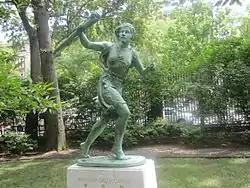
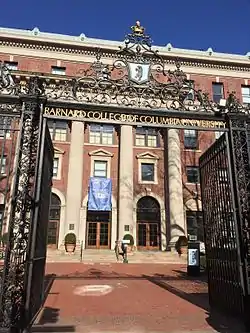
The Barnard Bulletin in 1976 described the relationship between the college and Columbia University as "intricate and ambiguous".[66] Barnard president Debora Spar said in 2012 that "the relationship is admittedly a complicated one, a unique one and one that may take a few sentences to explain to the outside community".[67]
Outside sources often describe Barnard as part of Columbia; The New York Times in 2013, for example, called Barnard "an undergraduate women's college of Columbia University".[7][68] Its front gates state "Barnard College of Columbia University".[69] Barnard describes itself as "both an independently incorporated educational institution and an official college of Columbia University"[70] that is "one of the University's four colleges, but we're largely autonomous, with our own leadership and purse strings",[71] and advises students to state "Barnard College, Columbia University" or "Barnard College of Columbia University" on résumés.[72] Facebook includes Barnard students and alumnae within the Columbia interest group.[73]
Columbia describes Barnard as an affiliated institution[74] that is a faculty of the university[75] or is "in partnership with" it.[76] Both the college and Columbia evaluate Barnard faculty for tenure,[77] and Barnard graduates receive Columbia diploma; signed by both the Barnard and the Columbia presidents.[78][79]
Before coeducation at Columbia
Smith and Columbia president Seth Low worked to open Columbia classes to Barnard students. By 1900 they could attend Columbia classes in philosophy, political science, and several scientific fields.[7] That year Barnard formalized an affiliation with the university which made available to its students the instruction and facilities of Columbia.[70] Franz Boas, who taught at both Columbia and Barnard in the early 1900s, was among those faculty members who reportedly found Barnard students superior to their male Columbia counterparts.[26] From 1955 Columbia and Barnard students could register for the other school's classes with the permission of the instructor; from 1973 no permission was needed.[8]
Except for Columbia College, by the 1940s other undergraduate and graduate divisions of Columbia University admitted women.[6] Columbia president William J. McGill predicted in 1970 that Barnard College and Columbia College would merge within five years. In 1973 Columbia and Barnard signed a three-year agreement to increase sharing classrooms, facilities, and housing, and cooperation in faculty appointments,[80] which they described as "integration without assimilation";[81] by the mid-1970s most Columbia dormitories were coed.[82] The university's financial difficulties during the decade increased its desire to merge[83] to end what Columbia described as the "anachronism" of single-sex education,[81] but Barnard resisted doing so because of Columbia's large debt,[82] rejecting in 1975 Columbia dean Peter Pouncey's proposal to merge Barnard and the three Columbia undergraduate schools.[80] The 1973–1976 chairwoman of the board at Barnard, Eleanor Thomas Elliott, led the resistance to this takeover.[84] The college's marketing emphasized the Columbia relationship, however, the Bulletin in 1976 stating that Barnard described it as identical to the one between Harvard College and Radcliffe College ("who are merged in practically everything but name at this point").[66]
After Barnard rejected subsequent merger proposals from Columbia and a one-year extension to the 1973 agreement expired, in 1977 the two schools began discussing their future relationship. By 1979 the relationship had so deteriorated that Barnard officials stopped attending meetings. Because of an expected decline in enrollment, in 1980 a Columbia committee recommended that Columbia College begin admitting women without Barnard's cooperation. A 1981 committee found that Columbia was no longer competitive with other Ivy League universities without women, and that admitting women would not affect Barnard's applicant pool. That year Columbia president Michael Sovern agreed for the two schools to cooperate in admitting women to Columbia, but Barnard faculty's opposition caused president Ellen Futter to reject the agreement.[80]
A decade of negotiations for a Columbia-Barnard merger akin to Harvard and Radcliffe had failed.[81] In January 1982, the two schools instead announced that Columbia College would begin admitting women in 1983, and Barnard's control over tenure for its faculty would increase;[80][6] previously, a committee on which Columbia faculty outnumbered Barnard's three to two controlled the latter's tenure.[81] Applications to Columbia rose 56% that year, making admission more selective, and nine Barnard students transferred to Columbia. Eight students admitted to both Columbia and Barnard chose Barnard, while 78 chose Columbia.[85] Within a few years, however, selectivity rose at both schools as they received more women applicants than expected.[6]
After coeducation
The Columbia-Barnard affiliation continued.[81] As of 2012 Barnard pays Columbia about $5 million a year under the terms of the "interoperate relationship", which the two schools renegotiate every 15 years.[67] Despite the affiliation Barnard is legally and financially separate from Columbia, with an independent faculty and board of trustees. It is responsible for its own separate admissions, health, security, guidance and placement services, and has its own alumnae association. Nonetheless, Barnard students participate in the academic, social, athletic and extracurricular life of the broader University community on a reciprocal basis. The affiliation permits the two schools to share some academic resources; for example, only Barnard has an urban studies department, and only Columbia has a computer science department. Most Columbia classes are open to Barnard students and vice versa. Barnard students and faculty are represented in the University Senate, and student organizations such as the Columbia Daily Spectator are open to all students. Barnard students play on Columbia athletics teams, and Barnard uses Columbia email, telephone and network services.[67][79]
Barnard athletes compete in the Ivy League (NCAA Division I) through the Columbia/Barnard Athletic Consortium, which was established in 1983. Through this arrangement, Barnard is the only women's college offering Division I athletics.[86] There are 15 intercollegiate teams, and students also compete at the intramural and club levels. From 1975–1983, before the establishment of the Columbia/Barnard Athletic Consortium, Barnard students competed as the "Barnard Bears".[87] Prior to 1975, students referred to themselves as the "Barnard honeybears".[88]
Seven Sisters
Established within the Barnard Student Government Association (SGA), The Seven Sisters Governing Board represents Barnard College as part of the Seven Sisters Coalition, which is a group of representatives from student councils of the historic Seven Sisters colleges. The reps on the coordinating board of Seven Sisters Coalition are rotating every year to hold the annual Seven Sisters Conference in a serious but informal setting. The first Seven Sisters Conference was hosted by SGA student representatives at Barnard College in 2009.[89] In fall 2013, the conference was hosted by Vassar College during the first weekend of November. The major topic focused on inner college collaborations and differences in student government structures among Seven Sisters Colleges. The Seven Sisters Coordinating Board of Barnard brought six Barnard student representatives to attend the Fall Semester conference, which was hosted at Vassar College in the past fall semester. Based on the Coalition Coordinating Board Constitution established in February 2013, Students delegates were initiating projects in the aspects of public relations, alumni outreach and website management to promote the presence and development of the seven sisters culture. Meanwhile, The Barnard delegates engaged in discussions about the various structures of the student governments among the historic seven sisters colleges.[90]
Controversies
In the spring of 1960, Columbia University president Grayson Kirk complained to the president of Barnard that Barnard students were wearing inappropriate clothing. The garments in question were pants and Bermuda shorts. The administration forced the student council to institute a dress code. Students would be allowed to wear shorts and pants only at Barnard and only if the shorts were no more than two inches above the knee and the pants were not tight. Barnard women crossing the street to enter the Columbia campus wearing shorts or pants were required to cover themselves with a long coat.[91][92]
In March 1968, The New York Times ran an article on students who cohabited, identifying one of the persons they interviewed as a student at Barnard College from New Hampshire named "Susan".[93] Barnard officials searched their records for women from New Hampshire and were able to determine that "Susan" was the pseudonym of a student (Linda LeClair) who was living with her boyfriend, a student at Columbia University. She was called before Barnard's student-faculty administration judicial committee, where she faced the possibility of expulsion. A student protest included a petition signed by 300 other Barnard women, admitting that they too had broken the regulations against cohabitating. The judicial committee reached a compromise and the student was allowed to remain in school, but was denied use of the college cafeteria and barred from all social activities. The student briefly became a focus of intense national attention. She eventually dropped out of Barnard.[8][94][95]
Administration
The following lists all the Presidents and Deans of Barnard College from 1889 to present.[96][97]

- Ella Weed (1889–1894)
- Emily James Smith (1894–1900)
- Laura Drake Gill (1901–1907)
- Virginia Gildersleeve (1911–1947)
- Millicent McIntosh (1952–1962)
- Rosemary Park (1962–1967)
- Martha Peterson (1967–1975)
- Jacquelyn Mattfeld (1976–1981)
- Ellen Futter (1981–1993)
- Judith Shapiro (1994–2008)
- Debora Spar (2008–2017)
- Sian Beilock (2017–present)
Notable people
Barnard College has graduated many prominent leaders in science, religion, politics, the Peace Corps, medicine, law, education, communications, theater, and business; and acclaimed actors, architects, artists, astronauts, engineers, human rights activists, inventors, musicians, philanthropists, and writers. Among these include: United Nations Development Programme Representative of Japan, Akiko Yuge (1975), academic Louise Holland (1914), author Zora Neale Hurston, author and political activist Grace Lee Boggs (1935), television host Ronnie Eldridge (1952), Phyllis E. Grann CEO of Penguin Putnam,[98] U.S. Representative Helen Gahagan (1924), CEO of CARE USA and chair of the Presidential Advisory Council on HIV/AIDS Helene D. Gayle (1970), President of the American Civil Liberties Union Susan Herman (1968), Chief Judge of the New York Court of Appeals Judith Kaye (1958), Chair of the National Labor Relations Board Wilma B. Liebman (1971), musician and performance artist Laurie Anderson (1969), actress, activist and gubernatorial candidate Cynthia Nixon (1988), author of The Sisterhood of the Traveling Pants Ann Brashares (1989), actress from Grey's Anatomy Kelly McCreary (2003), writer and director Greta Gerwig (2004), and Disney Channel actress Christy Carlson Romano (2015).
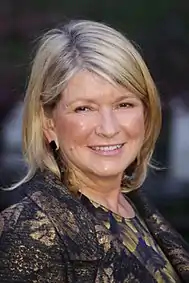 Martha Stewart '63, American businesswoman and television personality
Martha Stewart '63, American businesswoman and television personality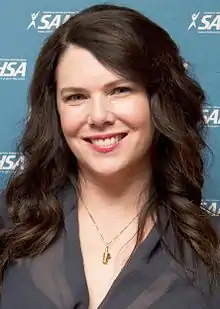 Lauren Graham '88, actress and author
Lauren Graham '88, actress and author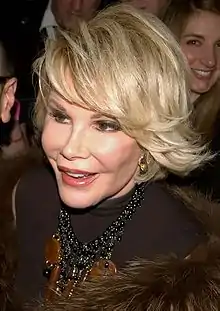 Joan Rivers '55, comedian and actress
Joan Rivers '55, comedian and actress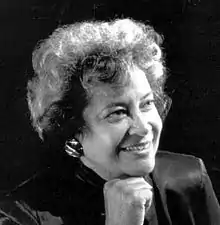 Norma Merrick Sklarek (1944-45), architect
Norma Merrick Sklarek (1944-45), architect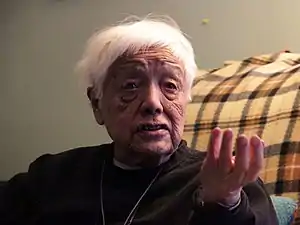 Grace Lee Boggs '35, author, social activist, philosopher
Grace Lee Boggs '35, author, social activist, philosopher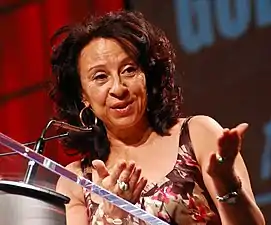 Maria Hinojosa '85, journalist, activist
Maria Hinojosa '85, journalist, activist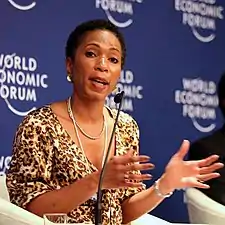 Helene D. Gayle '76, physician, public health official
Helene D. Gayle '76, physician, public health official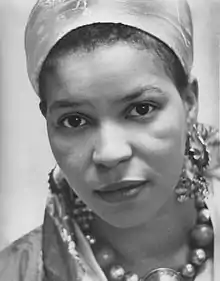 Ntozake Shange '70, playwright, poet, author
Ntozake Shange '70, playwright, poet, author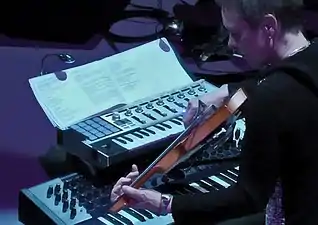 Laurie Anderson '69, performance artist and NASA's first Artist-in-Residence
Laurie Anderson '69, performance artist and NASA's first Artist-in-Residence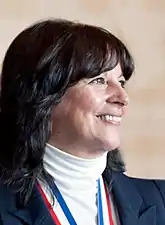 Jacqueline K. Barton '74, pioneer in the study of DNA structure
Jacqueline K. Barton '74, pioneer in the study of DNA structure.png.webp) Jhumpa Lahiri '89, author
Jhumpa Lahiri '89, author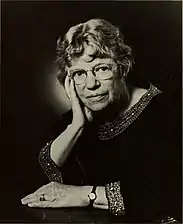 Margaret Mead '23, anthropologist
Margaret Mead '23, anthropologist.jpg.webp) Cynthia Nixon '88, actor, politician
Cynthia Nixon '88, actor, politician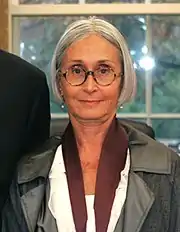 Twyla Tharp '63, choreographer
Twyla Tharp '63, choreographer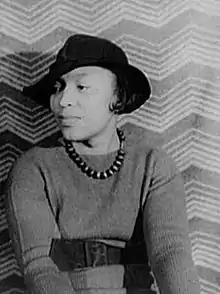 Zora Neale Hurston '28, author
Zora Neale Hurston '28, author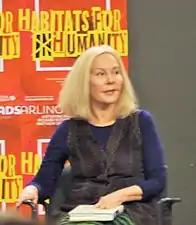 Katherine Boo '88, journalist and recipient of the Pulitzer and MacArthur Foundation prizes
Katherine Boo '88, journalist and recipient of the Pulitzer and MacArthur Foundation prizes
See also
References
Citations
- As of June 30, 2019. "U.S. and Canadian 2019 NTSE Participating Institutions Listed by Fiscal Year 2019 Endowment Market Value, and Percentage Change in Market Value from FY18 to FY19 (Revised)". National Association of College and University Business Officers and TIAA. Retrieved April 21, 2020.
- "Barnard College Common Data Set 2019-2020, Part I" (PDF). Barnard College.
- "Barnard College Common Data Set 2019-2020, Part B" (PDF). Barnard College.
- "At-a-Glance". Barnard College. Archived from the original on April 17, 2014. Retrieved May 15, 2014.
- "Athletics". Women's NCAA Athletics. Barnard College. Retrieved April 29, 2020.
- Farmer, Melanie. "College Marks 25 years of Coeducation". The Record. Retrieved October 23, 2014.
- Weneck, Bette (Spring 1991). "Social and Cultural Stratification in Women's Higher Education: Barnard College and Teachers College, 1898–1912". History of Education Quarterly. 31 (1): 1–25. doi:10.2307/368780. JSTOR 368780.
- Rosenberg, Rosalind (September 21, 1999). "The Woman Question". Barnard College. Archived from the original on July 5, 2008. Retrieved July 26, 2008.
- "First Barnard Board of Trustees, 1889". Alma Mater: The History of American Colleges & Universities. Retrieved July 3, 2020.
- Putnam, Emily Jane (1900). "The rise of Barnard College". Columbia University Quarterly. II (3): 209–217. Retrieved July 2, 2020.
- Pinsky, Paulina Marie (February 23, 2015). "Barnard's Original Women Trustees Original Women on the Board of Trustees". Columbia University. Retrieved July 2, 2020.
- "Barnard College: An Early Timeline, To 1939 | Barnard 125". Retrieved October 12, 2020.
- Dolkart 1998, p. 215.
- Dolkart 1998, p. 209.
- Dolkart 1998, p. 210.
- "GIFTS TO BARNARD COLLEGE; TWO HUNDRED THOUSAND DOLLARS FOR A BUILDING FUND. Money Needed for Land on Morningside Heights -- Money Guaranteed for Post-Graduate Professors". The New York Times. February 19, 1895. ISSN 0362-4331. Retrieved December 23, 2019.
- Dolkart 1998, pp. 211–214.
- "National Register Information System". National Register of Historic Places. National Park Service. March 13, 2009.
- "Mrs. John Cosgrave Is Dead Founded Finch Junior College: Was Institution's President Nearly 50 Years; Coined 'Current Events' Phrase". New York Herald Tribune. November 1, 1949.
- Plimpton Papers, Barnard College Archives
- Dolkart 1998, p. 217.
- Dolkart 1998, pp. 218–219.
- Kathleen A. Howe (June 2003). "National Register of Historic Places Registration: Brooks and Hewitt Halls". New York State Office of Parks, Recreation and Historic Preservation. Retrieved March 19, 2011.
- Dolkart 1998, pp. 220–221.
- Dolkart 1998, p. 223.
- Zimmerman, Jonathan (March 14, 2012). "Barnard College flap: Competition among women shouldn't be over men". Christian Science Monitor. Retrieved March 1, 2013.
- Maeroff, Gene I. (May 30, 1980). "Tie to Columbia Called Big Issue In Mattfeld Shift; Barnard President Seen as Too Intensely Opposed Areas of Disagreement Autonomy and Affiliation Turnover in Personnel". New York Times.
- "Barnard at a Glance". Barnard College. Archived from the original on August 3, 2016. Retrieved August 7, 2016.
- "Facts & Stats | Barnard College". barnard.edu. Retrieved November 12, 2019.
- "Foundations | Barnard College". barnard.edu. Retrieved November 12, 2019.
- "Barnard College Admits 1,022 to the Class of 2024 | Barnard College". Barnard College. Retrieved March 30, 2020.
- "Barnard College Common Data Set 2019-2020, Part C" (PDF). Barnard College. Retrieved April 29, 2020.
- "Barnard College Common Data Set 2018-2019, Part C" (PDF). Barnard College. Retrieved April 29, 2020.
- "Barnard College Common Data Set 2017-2018, Part C" (PDF). Barnard College. Retrieved April 29, 2020.
- "Barnard College Common Data Set 2016-2017, Part C" (PDF). Barnard College. Retrieved April 29, 2020.
- U.S. News & World Report https://www.usnews.com/best-colleges/barnard-college-2708. Archived from the original on September 19, 2008. Retrieved November 12, 2019. Missing or empty
|title=(help) - Barnard College (March 23, 2017). "Nation's Top Women's College Admits Most Selective Class in 127 Year History". Barnard Website. Retrieved December 6, 2017.
- "Rankingsandreviews.com". Colleges.usnews.rankingsandreviews.com. Retrieved February 20, 2011.
- "Barnard admissions rate falls to record low 11.3 percent for class of 2023 – Columbia Daily Spectator". columbiaspectator.com. Retrieved November 12, 2019.
- "Barnard College will now accept transgender women". CNN. June 4, 2015.
- "America's Top Colleges 2019". Forbes. Retrieved August 15, 2019.
- "Wall Street Journal/Times Higher Education College Rankings 2021". Wall Street Journal/Times Higher Education. Retrieved October 20, 2020.
- "Best Colleges 2021: National Liberal Arts Colleges". U.S. News & World Report. Retrieved September 24, 2020.
- "2020 Liberal Arts Rankings". Washington Monthly. Retrieved August 31, 2020.
- "Barnard College Rankings". U.S. News & World Report. 2021. Retrieved October 1, 2020.
- "America's Top Colleges". Forbes. August 15, 2019.
- Peet, Lisa (January 22, 2015). "Plans for New Barnard Library Prove Divisive". Library Journal.
- "Facilities: Buildings". New York, N.Y.: Barnard College. Archived from the original on August 31, 2016.
- "Teaching and Learning Center: New Building FAQs". New York, N.Y.: Barnard College. Retrieved September 15, 2016.
- "Teaching and Learning Center: LeFrak Center". New York, N.Y.: Barnard College. Archived from the original on September 15, 2016. Retrieved September 15, 2016.
- "Barnard Books in Milstein Rooms at Butler Library". BLAIS. barnard.edu. Retrieved June 30, 2016.
- "Follow Your Heart to the LeFrak Center". BLAIS. barnard.edu. Retrieved June 30, 2016.
- "About Us". BLAIS. barnard.edu. Retrieved June 30, 2016.
- Schuessler, Jennifer (April 15, 2016). "Ntozake Shange Archive Goes to Barnard". New York Times. Retrieved June 30, 2016.
- "Digital Exhibit of Barnard Publications". BLAIS. barnard.edu. Retrieved June 30, 2016.
- Freedman, Jenna (2009). "Grrrl Zines in the Library". Signs. 35 (1): 52–59. doi:10.1086/599266. JSTOR 10.1086/599266.
- "About Zines at Barnard". New York, N.Y.: Barnard Zine Collection; Barnard College. Retrieved September 15, 2016.
- "About the Collection". New York, N.Y.: Barnard Zine Collection; Barnard College. Retrieved September 15, 2016.
- "About Us: Our Collections". New York, N.Y.: Barnard Library. Retrieved September 15, 2016.
- "Student Government Association | Barnard College". barnard.edu. Retrieved June 11, 2016.
- "Barnard Fraternity Ban of 1913". Sororities- Barnard Archives and Special Collections. Barnard Archives and Special Collections. Retrieved April 29, 2020.
- Barnard funding for sororities, but not recognition | Columbia Daily Spectator. Columbiaspectator.com. Retrieved on September 7, 2013.
- Nicholas Bergson-Shilcock (March 16, 2007). "Take Back the Night". Columbia.edu. Retrieved February 20, 2011.
- "A Barnard Tradition: Midnight Breakfast | Barnard College". barnard.edu. Retrieved June 11, 2016.
- "Community-Student Life". Barnard. Retrieved April 26, 2019.
- "Is the Customer Always Right?". Barnard Bulletin (Editorial). February 1, 1976. p. 8. Retrieved February 3, 2016.
- Stallone, Jessica. "Barnard, CU legally bound, but relationship not always certain for students". Columbia Spectator. Retrieved February 18, 2012.
- Kaminer, Ariel; Leonard, Randy (May 9, 2013). "Reports of Cheating at Barnard Cause a Stir". The New York Times. pp. A25. Retrieved January 4, 2016.
- Teichman, Alysa (October 29, 2008). "50 Most Expensive Colleges / Barnard College". Bloomberg Businessweek. Retrieved December 8, 2012.
- "Barnard College Course Catalogue". Barnard.edu. Archived from the original on February 21, 2011. Retrieved February 20, 2011.
- "Our Partnership with Columbia University". Barnard College. Retrieved September 18, 2019.
- "Resume and Cover Letter Samples". Beyond Barnard Online Career Resources. Retrieved September 18, 2019.
- "Why is Barnard part of the Columbia network?". Alumnae Affairs, Barnard College. Retrieved July 10, 2012.
- "Undergraduate education at Columbia is offered through Columbia College, the Fu Foundation School of Engineering and Applied Science, and the School of General Studies. Undergraduate programs are offered by two affiliated institutions, Barnard College and Jewish Theological Seminary."
- "Organization and Governance of the University". Faculty Handbook 2008. Columbia University. November 2008. Retrieved July 5, 2012.
- "Frequently Asked Questions – Engineering". Undergraduate Admissions, Columbia University. Retrieved March 26, 2014.
- Principles and Customs Governing the Procedures of Ad Hoc Committees and University-Wide Tenure Review. Retrieved November 27, 2009.
- "Charters and Statutes" (PDF).
- "About the College: Partnership with Columbia". Barnard College. 2011. Archived from the original on February 18, 2011.CS1 maint: unfit URL (link)
- "The Road to Coeducation". Columbia Spectator. August 29, 1983. Retrieved September 26, 2012.
- "Columbia Decides to Go Coed". Time. February 1, 1982. Archived from the original on July 15, 2009.
- "A Survey of Co-education in The Ivies". Harvard Crimson. October 4, 1974. Retrieved March 1, 2013.
- Hartocollis, Anemona (September 24, 1975). "Financial Difficulties Prompt Columbia Report on Merger". Harvard Crimson. Retrieved March 1, 2013.
- "Eleanor Thomas Elliott, 80, Barnard Figure". The New York Times. December 6, 2006. ISSN 0362-4331. Retrieved March 23, 2017.
- Belkin, Lisa (September 2, 1983). "First Women Enrolled at Columbia College". The Palm Beach Post. New York Times. pp. B8. Retrieved March 6, 2013.
- Athletics
- "magazine-spring09/6". Issuu.com. May 18, 2009. Retrieved February 20, 2011.
- "Columbia Daily Spectator 21 February 1964 — Columbia Spectator". spectatorarchive.library.columbia.edu. Retrieved June 11, 2016.
- Seven Sisters Student Coalition. "Leadership Conference". Retrieved March 5, 2014.
- Seven Sisters Coalition. "Coalition Coordinating Board Constitution". Retrieved March 5, 2014.
- "Ban on Shorts Threatens Classic Barnard Couture". The New York Times. April 28, 1960. p. 1.
- "Administrative Regulations: Campus Etiquette". Barnard College Blue Book. pp. 87–88.
- Klemesrud, Judy (March 4, 1968). "An arrangement: living together for convenience, security, sex". The New York Times.
- Newsweek, April 8, 1968, p. 85 and Newsweek, April 29, 1968, p. 79-80.
- Bailey, Beth L. (1999). Sex in the heartland. Harvard University Press. p. 201. ISBN 0-674-00974-6.
- Past Presidents
- Harris, Elizabeth A. (May 22, 2017). "Barnard Chooses a Leader Whose Research Focuses on Women". The New York Times. Retrieved February 17, 2018.
- Maneker, Marion (January 1, 2002). "Now for the Grann Finale". New York Magazine. Retrieved May 23, 2018.
Sources
- Dolkart, Andrew S. (1998). Morningside Heights: A History of its Architecture and Development. Columbia University Press. ISBN 978-0-231-07850-4. OCLC 37843816.CS1 maint: ref=harv (link)
- Horowitz, Helen Lefkowitz (1993). Alma Mater: Design and Experience in the Women's Colleges from Their Nineteenth-Century Beginnings to the 1930s (2nd edition). Amherst: University of Massachusetts Press.
External links
| Wikisource has the text of the 1905 New International Encyclopedia article "Barnard College". |
| Wikimedia Commons has media related to Barnard College. |
